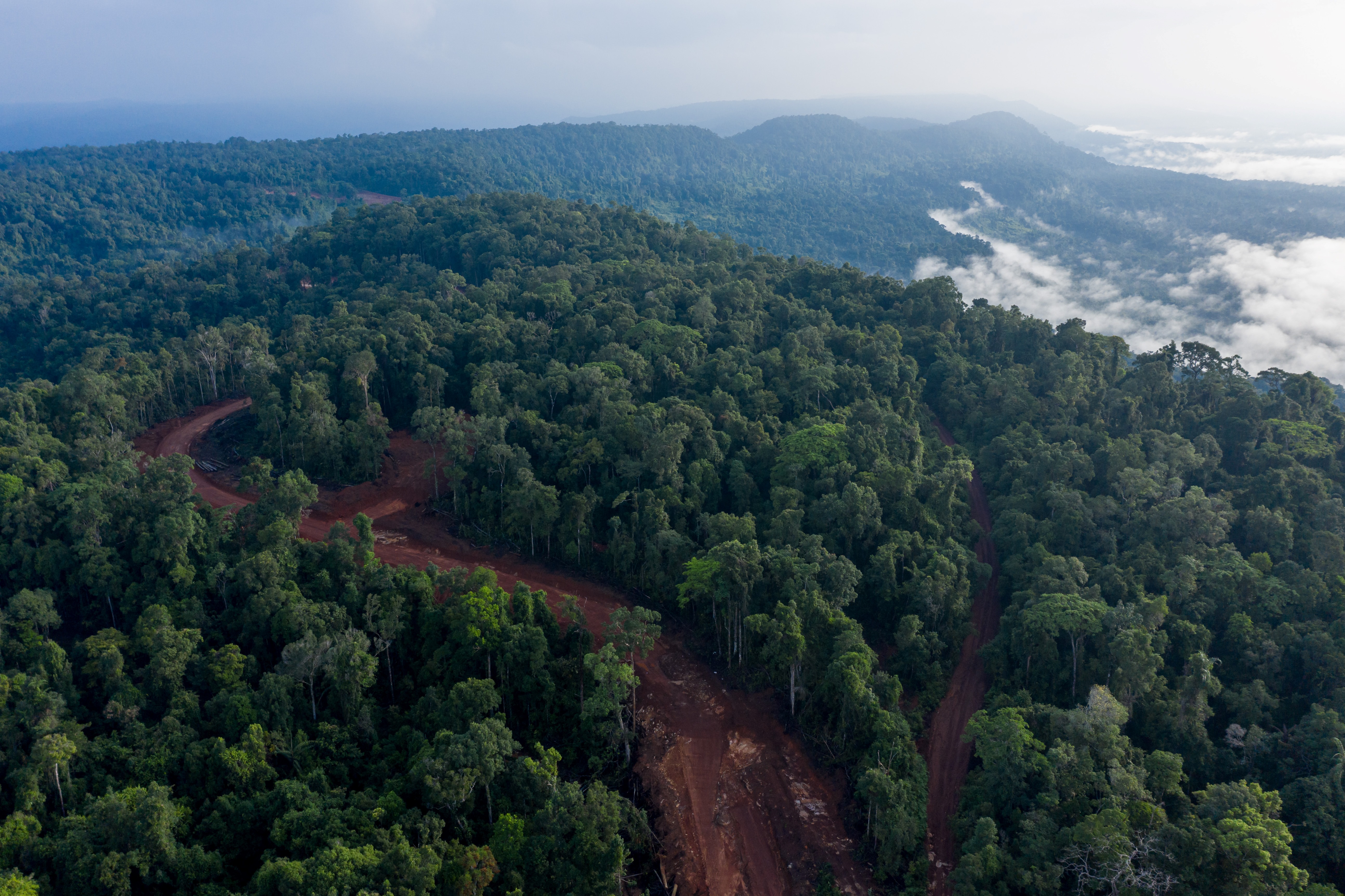Andy Ball and Vutha Srey contributed to this report.
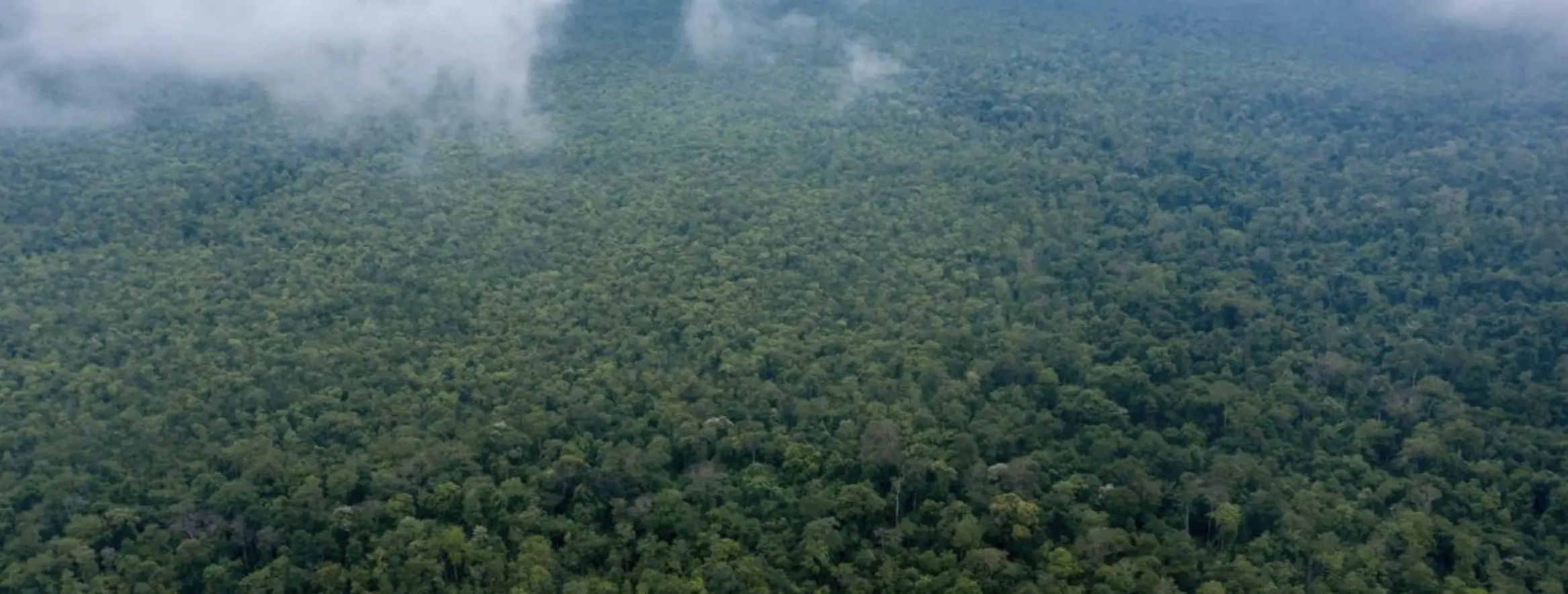
- In November 2021, the Cambodian government approved the development of 299 kilometers (186 miles) of 500-kilovolt power lines through Prey Lang Wildlife Sanctuary by Schneitec Northern to link Phnom Penh’s electrical grid to two coal-fired power plants in Laos, following a power purchase agreement signed in October 2019. The power lines are planned to transect the largest tract of lowland evergreen forest remaining in Southeast Asia, and critics say the project puts at risk at risk one of the country’s largest carbon stocks as well as poses a threat to Prey Lang’s Indigenous residents and two watersheds vital to Tonle Sap Lake, which sustains millions of Cambodians.
- Leaked documents from April 2021 show that the consulting firm that conducted the environmental impact assessment had suggested three possible routes for Schneitec’s power lines, with two alternative routes that skirted the already-deforested eastern and western edges of the protected area respectively. Industry experts have suggested that building power lines through forested terrain can cost between 1.5 and three times as much as through scrubland or flat terrain.
- The power line plans come as satellite data reveal 2021 was the worst year on record for deforestation in Prey Lang and international institutions condemn widespread illegal logging in the protected area.
PHNOM PENH — At last year’s COP26, the annual U.N. climate summit, Cambodian Environment Minister Say Samal voiced his support for more carbon credit projects in the country as part of his request for greater climate financing. Notably, though, he avoided making Cambodia a signatory to the Glasgow Leaders’ Declaration on Forest and Land Use, which would have committed Samal to preserving what remains of Prey Lang Wildlife Sanctuary and other protected forests.
However, despite his vocal support of REDD+ as a means of financing conservation, on Nov. 12, 2021, the government that Samal serves approved 299 kilometers (186 miles) of 500-kilovolt power lines that are set to cut Prey Lang Wildlife Sanctuary in half, while also running through two REDD+ projects at either end of the protected area.
One of those REDD+ projects is located in the Stung Treng province section of Prey Lang, where Conservation International partnered with Japanese trading house Mitsui and Cambodia’s Ministry of Environment in 2018. Now, the power lines are planned to cut through a significant portion of the REDD+ project’s accounting area, where carbon credits could potentially be generated after the project completes its ongoing accreditation process.

Whistleblowers and others in possession of sensitive information of public concern can now securely and confidentially share tips, documents, and data with the Pulitzer Center’s Rainforest Investigations Network (RIN), its editors, and journalists.
Having already seen the second phase of the Mitsui REDD+ project affected by the government’s unexpected decision to open a limestone mine in the Kratie province section of Prey Lang, Conservation International’s Cambodia office issued a statement on the range of threats posed to the protected area.
“[D]eforestation of this scale anywhere within the Prey Lang Wildlife Sanctuary protected area is a concern for people, nature, and a stable climate,” said Srabani Roy, acting country director of Conservation International Cambodia. “[Conservation International] has and will continue to raise our concerns and share data and information on deforestation rates we have observed with the [Ministry of Environment] and [provincial department of environment].”
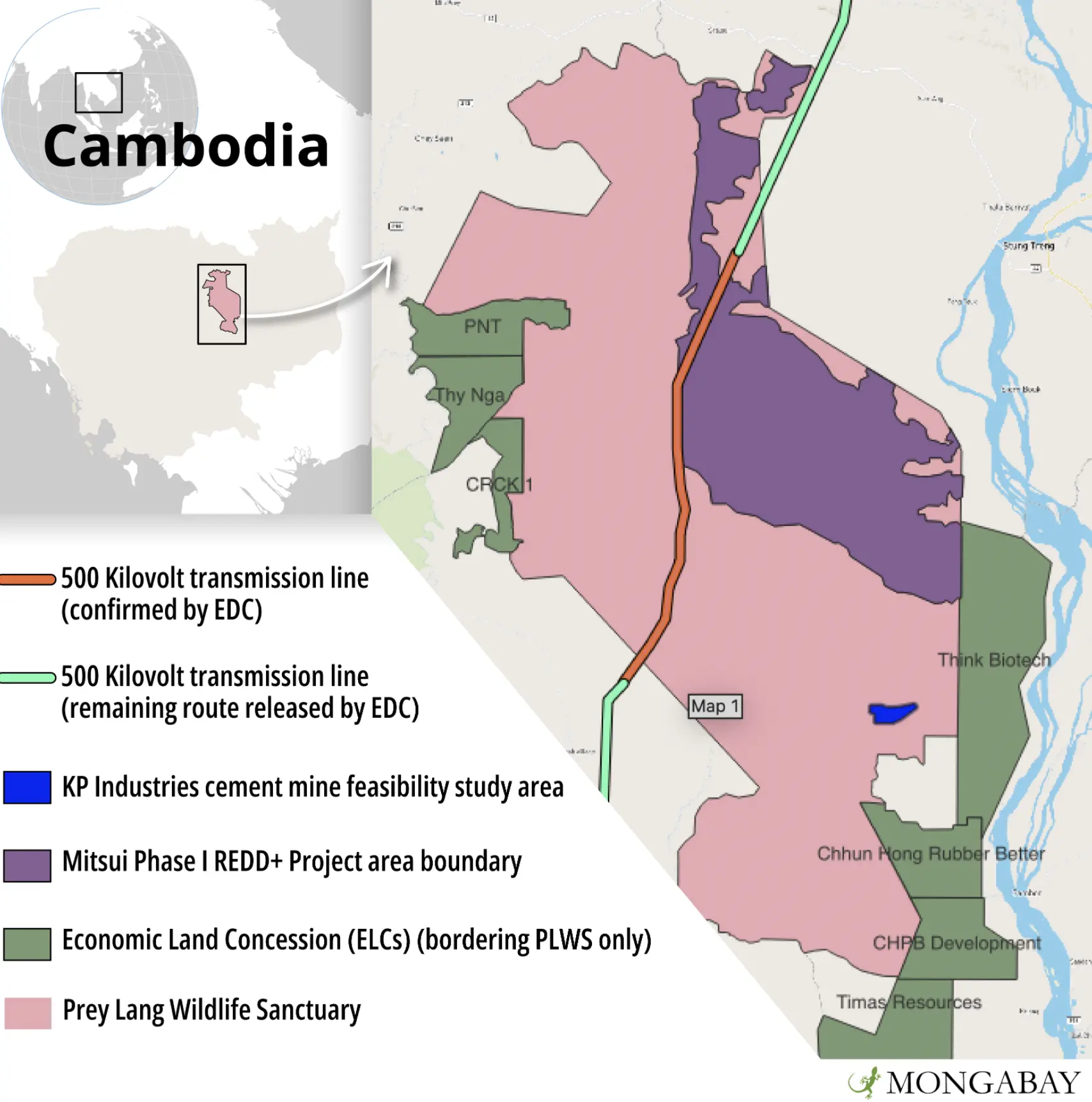
Critics say the government’s decision to run power lines right through the heart of Prey Lang Wildlife Sanctuary calls into question the viability of expanding REDD+ in the protected forest. However, Tim Frewer, an academic in Cambodia who has extensively studied Prey Lang, said the focus should be on how this decision affects the people who depend on the forest, rather than the international NGOs seeking to sell carbon credits from it.
“The focus should not be on whether or not the REDD+ is still viable, because REDD+ projects are incredibly convoluted with a myriad of ways to disappear local complexities through accounting procedures and glossy brochures,” Frewer said. “The focus should instead be on the people in and around Prey Lang and whose livelihoods and culture are tied into Prey Lang. These people already have an interest in protecting Prey Lang and have shown time and time again the sacrifices and risks they are willing [to take] to protect Prey Lang, their livelihoods and their culture.”
According to Frewer, the level of development in the form of land concessions authorized within and around Prey Lang highlights how short-term financial gains trump conservation goals in Cambodia.
“The problem is not whether the REDD+ project is doomed or not,” he added. “The biggest tragedy, which we are already heading towards, is if the project eventuates and successfully sells carbon credits, which will conceal and whitewash both the history of struggle by local communities to protect and maintain forest-based livelihoods, and the failure of government authorities to stop recent destruction.”
And so while it appears that the existing REDD+ projects in Prey Lang stand to be severely affected by the power line expansion, much more is at stake: the largest lowland evergreen forest left in Southeast Asia is set to be carved in two by Cambodia’s growing energy demands, putting at risk one of the country’s largest carbon stocks. The forest is also home to some 250,000 Indigenous people, along with a wide range of wildlife as well as two watersheds vital to Tonle Sap Lake, which sustains millions of Cambodians.
Under assault on all fronts
The transmission lines planned to transect Prey Lang aim to feed Phnom Penh’s electrical grid with power from two coal-fired plants in Laos, following a power purchase agreement signed in October 2019. On the Cambodian side, a substation was finished in early 2022, with pylons being constructed heading north from Kandal province on the outskirts of Phnom Penh, bound for Prey Lang Wildlife Sanctuary.
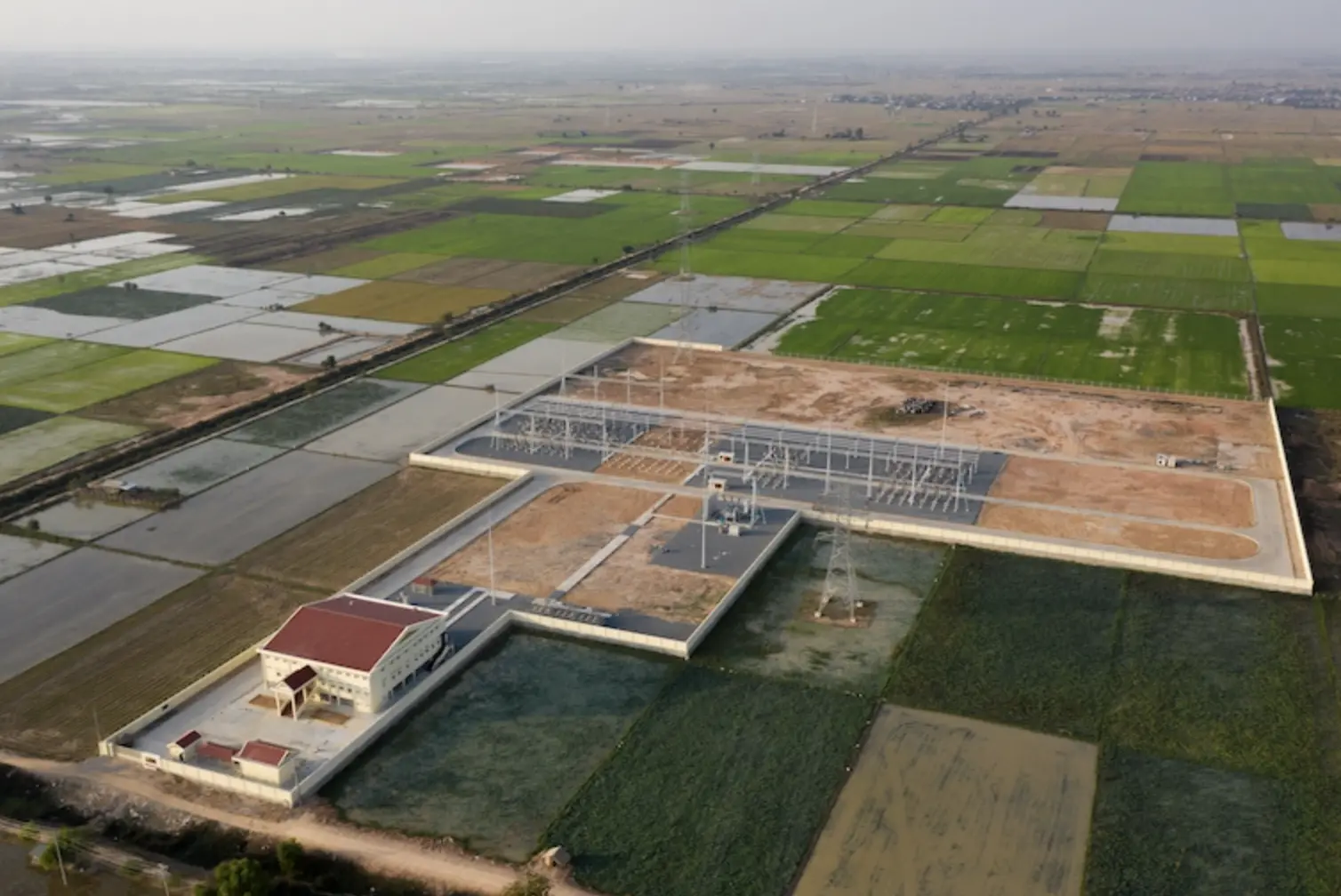
On the Laotian side, the anticipated 600-megawatt TSBP Sekong and Mineral Company Limited plant and 1,800-MW Xekong Thermal Power Plant Company Limited plants are not expected to generate the full 2,400 MW until 2027. However, the first phase is expected to be online by the end of 2024, generating 300 MW of power.
In February 2021, Laotian officials confirmed that both the TSBP Sekong and the Xekong plants would be built, with Thailand’s Phone Sack Group building the Xekong plant and an unnamed Chinese company handling the TSBP Sekong. But doubt has since been cast on whether these projects would materialize, given China’s September 2021 signal that it will no longer fund overseas coal projects.
Cambodian officials confirmed that, coal or no coal, the power lines set to carve up Prey Lang will go ahead regardless.
This comes at a time when Prey Lang is facing a fresh wave of threats: a new 938-hectare limestone mining concession was granted in the Kratie province section of the forest earlier this year to Chhay Chingheang, a wealthy businessman with ties to the highest echelons of government, while 2021 was shown to be the worst year on record for deforestation in the protected area, according to data from Global Forest Watch.
The continued assault prompted new research from Amnesty International, which, in January this year, found that the sustained rate of illegal logging was undermining human rights and played a large part in erasing the Indigenous culture of Kuy communities in Prey Lang. Meanwhile, authorities were accused of turning a blind eye to forest crimes committed by Vietnamese logging consortium PNT in the Preah Vihear section of Prey Lang; in Kampong Thom province, a $3.4 million Chinese plywood processing facility was given the official go-ahead in January 2022, further heightening the risk of timber laundering as opportunities to log the forest increase in line with development of the area.
But while Cambodian authorities continue to crack down on environmental activists, following the 2020 ban on forest patrols by grassroots conservationists at the Prey Lang Community Network (PLCN), large-scale destruction remains unaddressed, while those seeking to document forest crimes have become targets for the government. Other reports have suggested that the Ministry of Environment, along with officials from other government agencies, are complicit in the plundering of Prey Lang.
As such, Prey Lang, which straddles four provinces in Cambodia and is, on paper, 431,683 hectares (1.07 million acres) in size, has proven a largely contentious protected forest. So much so that USAID abandoned its $21 million Greening Prey Lang project in June 2021 due to the unrelenting appetite of logging magnates operating in the forest, choosing instead to work with local activists and communities.
An existential threat to the forest
While most threats to Prey Lang have been historical, long-term issues that the government has either refused to address or denied ever existed, the power lines present a new promise of irrevocable damage that will forever fragment one of Cambodia’s most hotly contested forests.
“If the power line goes through it is the death sentence to Prey Lang Wildlife Sanctuary,” said Ida Theilade, a professor at the University of Copenhagen who has studied Prey Lang extensively. “All scientific evidence shows that roads are correlated with rapid forest destruction. It will cut across the core area of the wildlife reserve, this is the area of most biodiversity value, the endemic swamp forest and the Kuy spiritual forests — the latter is correlated with high conservation value forest areas.”
Theilade said Cambodia only has to look to research from the late ecologist Thomas Lovejoy to understand the dangers associated with fragmenting forests in terms of losses to ecosystems and biodiversity.
“However, the degree of government collusion in the logging operations, including military units and police protecting the illegal logging operations, may be a sign that the Hun regime has already decided to log Prey Lang to the ground and the power line is just another step on the road to the total obliteration of Prey Lang,” Theilade said.
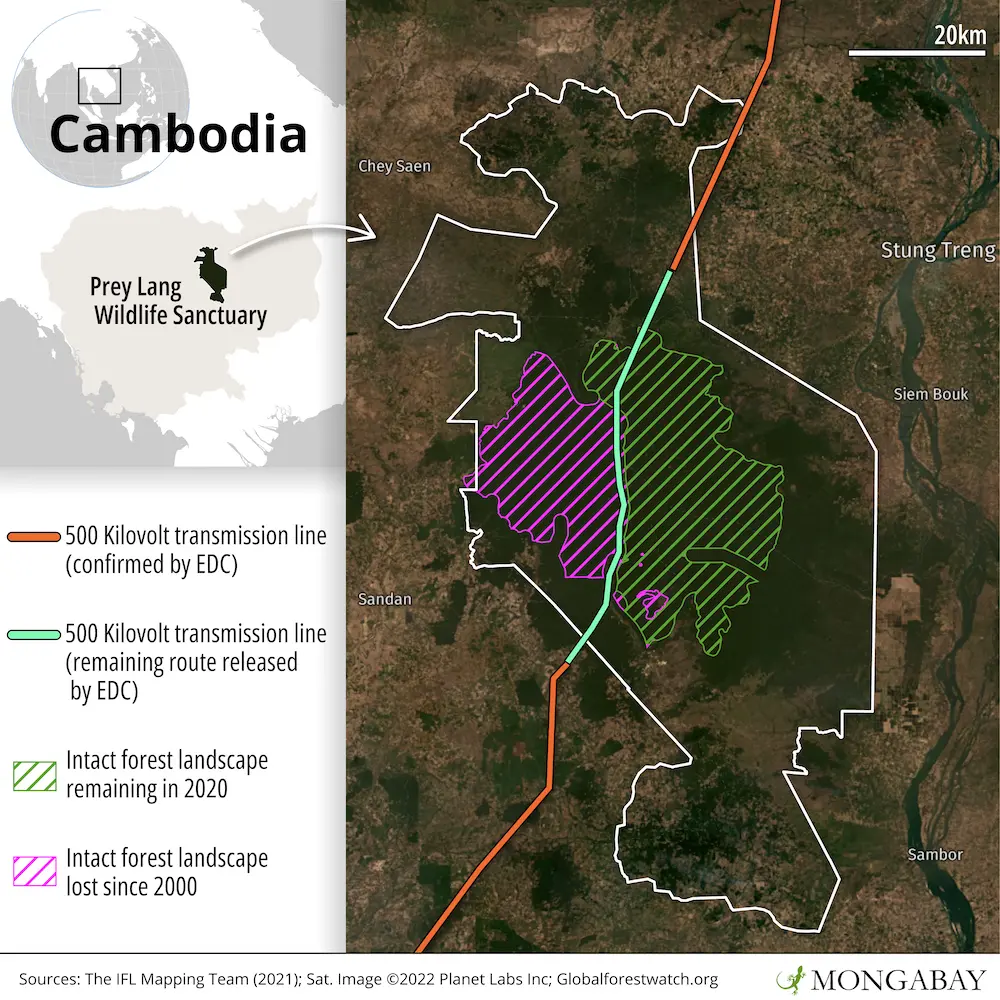
The company responsible for building these power lines is Schneitec Northern, which was established in December 2020 as part of Schneitec Group. The group consists of 10 companies all focused on energy infrastructure under Heng Socheat, chairman of the board of directors.
Schneitec first came to public attention through its development of solar farms in Cambodia, installing 60 MW of solar in Kampong Chhnang province and 80 MW in Kampong Speu province by April 2020. That same year, EnergyLab Cambodia, a local NGO focused on the country’s energy transition, estimated that Schneitec’s solar projects provided 4% of the total electricity in the national grid.
It was for this reason that Schneitec Group was awarded EnergyLab’s Clean Energy Award in October 2021, with Australian Ambassador Pablo Kang personally handing Socheat the award. This was just one month prior to the Cambodian government granting Schneitec the concession to carve up Prey Lang Wildlife Sanctuary and hook up transmission lines to Laotian coal plants.
Natharoun Ngo, EnergyLab’s country director, did not respond to requests for comment.
An absence of transparency
When initially contacted by journalists, Socheat declined to comment over the phone, demanding questions be written and delivered to his office before hanging up.
“The project company is executing our work as per the requirements by the Royal Government of Cambodia,” Socheat wrote in response to detailed questions. “We did not choose the specifications and scope of work, nor did we get to make the choice in the protected areas. Our investments reflect the amount of work we need to do as per the concession agreement we signed with the Royal Government of Cambodia through the Ministry of Mines and Energy.”
Socheat would not say whether an environmental impact assessment had been conducted or whether communities affected by the power lines had been consulted.
A representative of the PLCN said nobody from the company or the government had informed them of the power lines, but warned that the fragmentation of Prey Lang would lead to a loss of forest, wildlife and non-timber forest resources from which many Indigenous Kuy people make a sustainable living.
In a subsequent letter responding to follow-up questions sent by reporters, Socheat again declined to make the findings of the environmental impact assessment public, despite Schneitec’s purported “green” credentials.
“The project company commits to strictly execute our work along all requirements and recommendations by the Ministry of Environment in terms of the environmental impact assessment,” he wrote.
Keo Rattanak, head of Cambodia’s state-run electricity utility, Electricite du Cambodge (EDC), also declined to divulge details of the environmental impact assessment.
“All projects in the power sector need to obtain official approvals from the relevant government agencies,” Rattanak said. “For [environmental impact assessments], the Ministry of Environment is the competent authority responsible for reviewing and approving including necessary safeguards. The chosen line route in a small part of Prey Lang Wildlife Sanctuary is the result of a joint assessment between EDC and the Ministry of Environment during the conduct of the [environmental impact assessment].”
When asked about the findings of the assessment carried out by EDC and the Ministry of Environment, ministry spokesperson Neth Pheaktra said, “The Ministry of Environment, as well as the Royal Government of Cambodia, remains strongly committed to the protection and conservation of natural resources and biodiversity, and strives responsibly and professionally to minimize environmental and social impacts from development projects.”
However, the commitment to which Pheaktra alluded apparently does not stretch so far as to make the findings of Schneitec’s environmental impact assessment public, which neither Rattanak of EDC nor Socheat were willing to do. Cambodia’s law on environmental impact assessments suggests it is the responsibility of the Ministry of Environment to make the findings of these studies public, but this rarely happens and, in some cases, projects have been found to go ahead prior to an assessment being conducted.
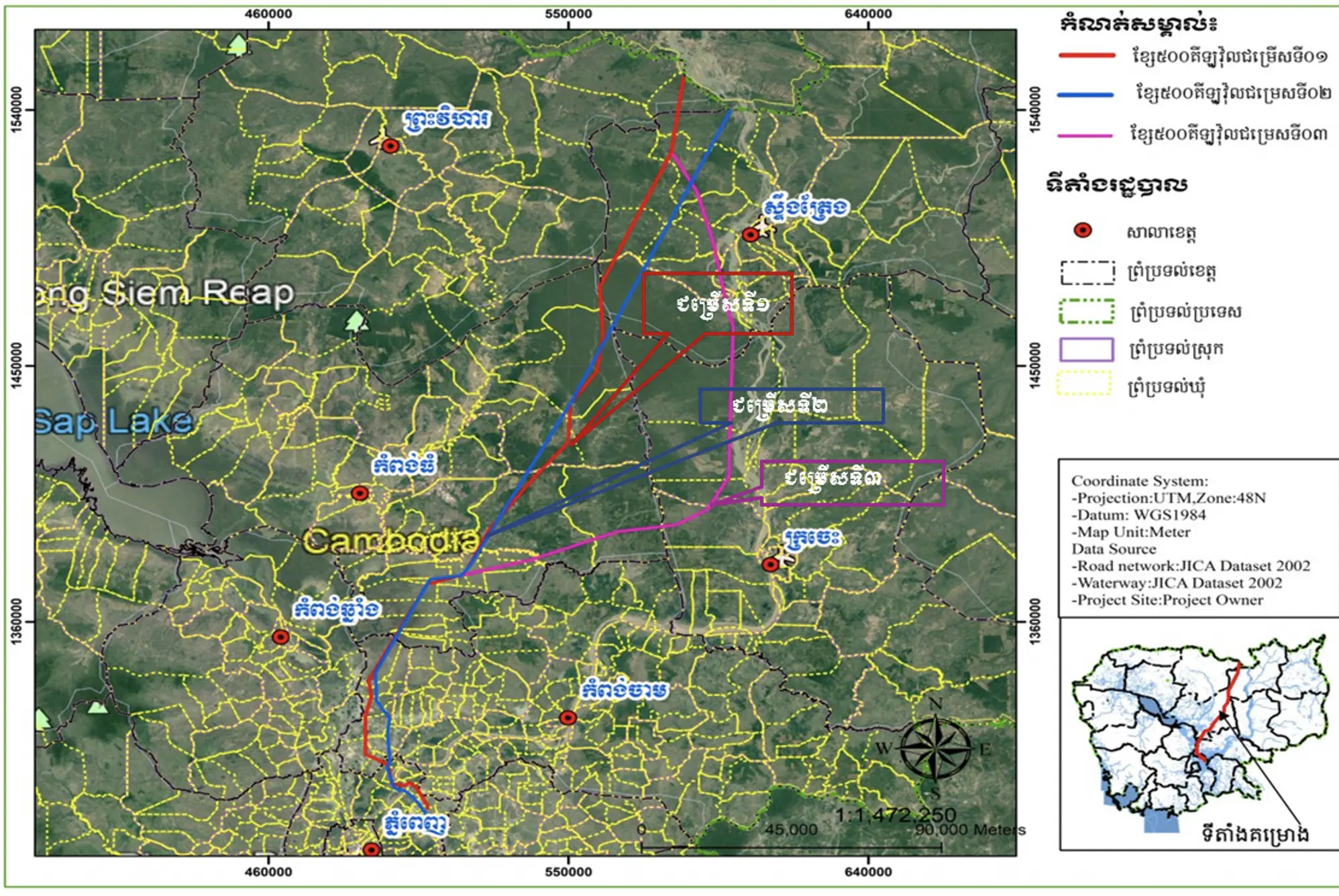
Leaked documents from April 2021 show that EDC and SBK Consultants, the firm that conducted the environmental impact assessment, had suggested three possible routes for Schneitec’s power lines, with two alternative routes that skirted the eastern and western edges of the protected area respectively. Other documents bearing the signature of Say Samal, the environment minister, show that he had attempted to block the preferred path of the power lines, which would cut Prey Lang in half. However, it is unclear who overruled the environment minister or why.
The documents also lay out cost breakdowns associated with each proposed route, with prices listed ranging from $227 million to $260 million. The route carving through the middle of Prey Lang was listed as the cheapest. Industry experts have suggested that building power lines through forested terrain can cost between 1.5 and three times as much as through scrubland or flat terrain.
According to Rattanak of the EDC, the finalized route of the power lines is a combination of the routes proposed in April 2021 and will run through approximately 20 km (12 mi) of scrubland and 40 km (25 mi) of forest within Prey Lang’s protected area.
Socheat, head of the company building the power lines, declined to say how much forest would be impacted, the exact length and cost of the power lines, or their route, pointing only to what he called “reliable websites” that lacked specific details, but suggested that the power lines will cost some $330 million.
An unclear relationship
While neither Socheat nor Rattanak were willing to disclose the impact of Schneitec’s project on Prey Lang, they were equally unwilling to explain the exact nature of their relationship.
Documents from the Japanese International Cooperation Agency dated December 2014 list a Heang Socheath as working at EDC’s procurement office, and while the transliteration of Socheat is a little off, EDC’s 2015 annual report includes a Heng Socheat who worked at EDC’s procurement office.
Schneitec Group was registered with Cambodia’s Ministry of Commerce in 2015, which is the most recent year that a Heng Socheat is listed as an EDC employee. But when asked if he had ever worked at EDC, Socheat replied, “Generally, this question shall go to [the] employer side.”
While Socheat neither confirmed nor denied having worked under Rattanak at EDC, Rattanak was equally evasive, refusing to detail the relationship he has with Socheat or whether Socheat worked for him at EDC at any point. But the connection appears to run deeper.
Keo Rattanak’s sister, Keo Rottany, is listed as a director of Victory Hill Inc. where her postal address, as registered with the Ministry of Commerce, is a house numbered 8A in Boeung Kak 1 commune, Toul Kork district, Phnom Penh.
Meanwhile, Keo Rattanak’s wife, Kheng Chansopheak, is an influential businessperson, serving on a company board with Pich Chanmony — wife of Hun Manet, Prime Minister Hun Sen’s eldest child, who is currently being groomed for the dynastic succession of his father. As 2022 is an election year, voter registration documents are displayed publicly in local government buildings, and in the Boeung Kak 1 commune office, Chansopheak is also listed at the same address as Keo Rattanak’s sister: 8A.
Publicly available voter registration documents show that Socheat of Schneitec is registered to vote at house 8B on the same street as both Rattanak’s wife and sister.
Upon checking the street in Boeung Kak 1 commune where house 8B is situated, reporters found only house 8 — a large compound comprising several villas — but no separate addresses for 8A or 8B.
When asked to explain this and whether it spoke of a more intimate relationship between Schneitec and EDC, Socheat detailed how his father, Kheun Heng, had, in 2002 or 2003 (he said he could not remember when exactly) sold a plot of land that included house number 8B in Boeung Kak 1 commune to Rattanak and Chansopheak, adding that any paperwork tying him to that address “is not intentional.”
Socheat added that he had, since 2002 or 2003, been living in Tumnup Toek commune, Chamkarmon district, Phnom Penh, and provided an address book that showed an address in Tumnup Toek commune, but lacked Heng Socheat’s name.
He repeatedly declined opportunities to explain more fully the relationship he shares with Rattanak and Chansopheak, stating, “We already clarified what you needed” three times in response to follow-up questions over messaging app Telegram, before requesting further questions be delivered to Schneitec Group’s office.
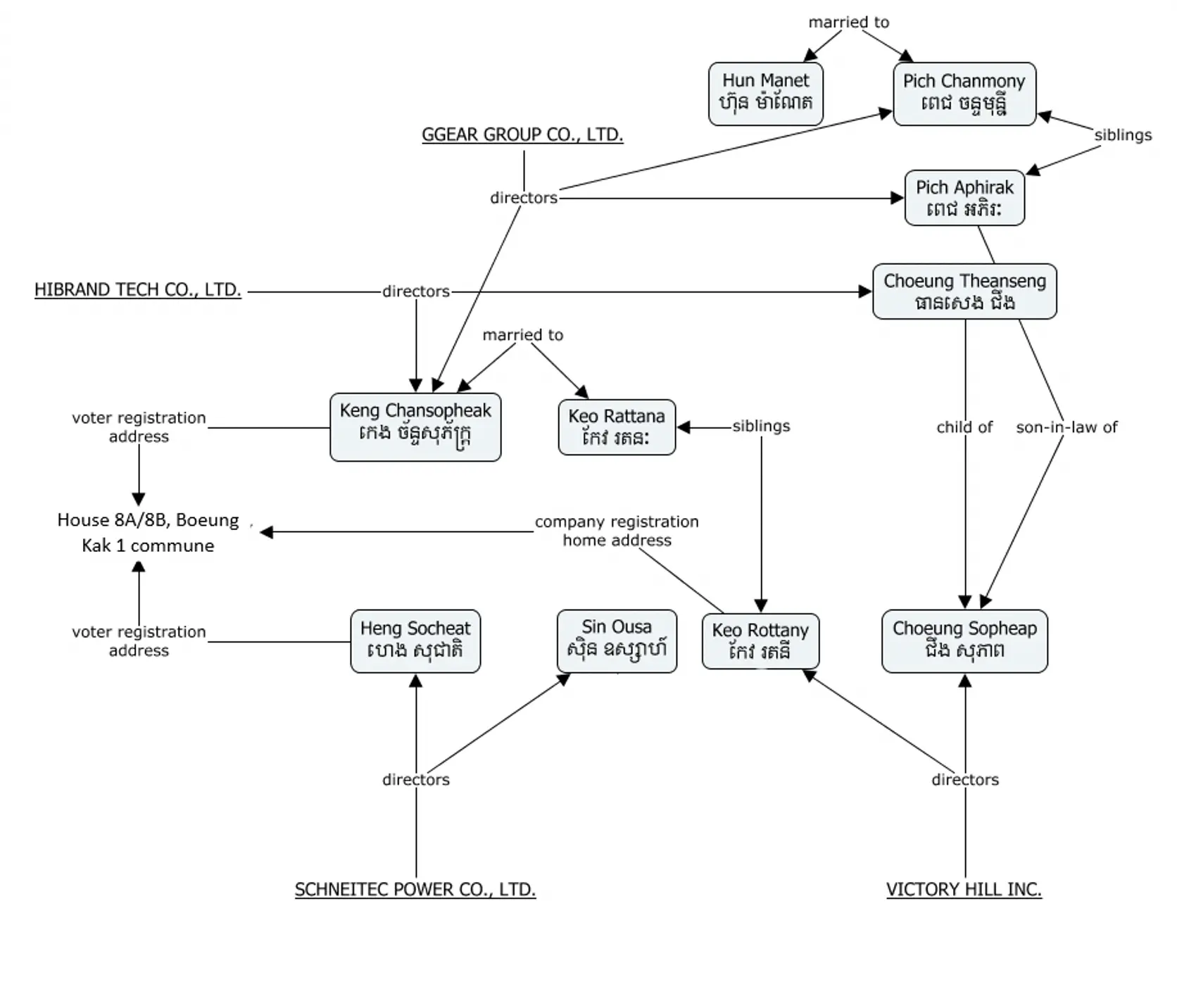
Rattanak also said he could not remember whether he had purchased the house from Socheat’s father in 2002 or 2003.
“This House 8 [street number removed for privacy] (no more 8B) has been our exclusive residence since the time of the purchase,” Rattanak said. “If there is anything to do with the previous owners, it would be the utilities bills that were used by them before the sale and these same bills are still being kept by utilities companies today."
“We do not have any knowledge that Mr. Heng Socheat and Mr. Kheun Heng still share our address. If they still do, it is not proper. Nevertheless, we are going to have our legal team contact them in due course and seek a clarification and correction,” he said, demanding to be quoted in full.
Rattanak then refused to answer follow-up questions and appears to have blocked reporters on Telegram since.
However, in 2016, Cambodia’s National Election Committee rebuilt the electoral register from scratch, meaning that every Cambodian in the country needed to reregister — a process that required valid proof of address.
Reporters checked with the Tumnup Toek commune voter registration list, but found only one Heng Socheat, whose date of birth did not match that on the identity card that Socheat of Schneitec provided reporters in response to initial questions over his address. By contrast, the date of birth on the identity card matches the Socheat registered to house 8B in Boeung Kak 1 commune.
When asked in writing, again, to explain the nature of his relationship with Rattanak and why he appears to be registered to vote within what Rattanak described as his “exclusive residence,” Socheat replied simply “We are officially and legally standing by our previous statement,” although it is unclear who “we” refers to beyond Socheat.
He added that he has “sufficient eviden[ce] to officially [and] legally prove” that he lives in Tumnup Toek commune, but did not share this evidence.
‘Not the best option’
As such, it is hard to determine the exact nature of Socheat’s relationship with Rattanak and subsequently Schneitec’s relationship with EDC. But the lack of transparency — and as a result, accountability — fits a pattern in Cambodia’s energy sector.
The Asian Development Bank (ADB) in December 2018 reported that Cambodia’s power development planning process was overly reliant on unsolicited bids and “business-to-business arrangements.”
“The capacity of EDC to scale up clean energy generation through the private sector and public-private partnerships is limited,” the ADB wrote. “The utility needs more experience in conducting competitive tenders in a structured approach, which requires standard tender documents, [power purchase agreement] templates, and established procedures for the review of investment proposals.”
Four years have passed since the ADB called for Cambodia’s energy sector to become “more structured and transparent,” and yet the relationship between EDC and Schneitec remains as opaque as ever; it is unclear who, if anyone, benefits from the relationship, whatever its nature may be. But such a lack of transparency appears to be allowing an infrastructure project to effectively cut a protected forest on state public land in two, and those involved seem committed to hiding how this project came to be as well as its ecological and social consequences.
Those working in Cambodia’s energy sector not only recognized that corruption and nepotism have long gone unaddressed, but noted that Schneitec’s power lines reflect a myopic energy policy that could fail to deliver on the long-term benefits promised, leaving Prey Lang irrevocably fragmented for nothing.
One industry expert, who requested anonymity due to the nature of their work with the government, said the decision to purchase coal power from Laos was “not the best option” and that the 2019 power purchase agreement “condemns Cambodia to the coal strategy,” warning that the Laotian power plants could rapidly become stranded assets if the cost of coal increases, further pushing up Cambodia’s electricity prices.
They stressed that regional integration of power grids was important and greater connectivity between Laos and Cambodia could take pressure off Vietnam, whose national grid is regarded as more stable and as such does much of the region’s heavy lifting. However, the expert noted that the costs, both financial and environmental, associated with the Cambodia-Laos transmission lines far exceed what it would cost for Cambodia to make long-term investments in upgrading the national grid and developing more renewable energy capacity.
“All development involves trade-offs, but some projects are more impactful than others,” said Courtney Weatherby of the Stimson Center, a U.S.-based think tank with various projects in the Mekong region. “Cambodia needs electricity — but it has a range of options which could help meet rapidly rising demand, and so Cambodia doesn’t necessarily need to lock in new coal-fired electricity imports from Laos.”
Weatherby pointed to Cambodia’s abundant potential for solar and highlighted how successful this has been in Vietnam, suggesting that Cambodia seize this opportunity to expand domestic power production rather than rely on further imports. Weatherby said that if the power lines must go ahead, Cambodia could easily find alternatives to coal as southern Laos’s options widen in the face of an accelerating energy transition.
Whether this trade-off is one that will benefit Cambodia remains to be seen, but Prey Lang and its inhabitants can expect to see few positives from Schneitec’s plans, according to Courtney Work, an associate professor at the National Chengchi University in Taiwan.
“We can say that industrial development in forested areas where market-independent communities have been living for generations completely transforms the ways that people live, their traditions, and their social cohesion,” said Work, who has studied Indigenous communities across Cambodia for years.
“These are elements widely reported across the Prey Lang region right now, and very few families are able to support themselves from the forest any more. The further impacts of this power line project are impossible to know, but there is no reason to think that it will enhance the livelihoods, traditions, and social health of the region.”
Citation:
Do, T. N., Burke, P. J., Nguyen, H. N., Overland, I., Suryadi, B., Swandaru, A., & Yurnaidi, Z. (2021). Vietnam’s solar and wind power success: Policy implications for the other ASEAN countries. Energy for Sustainable Development, 65, 1-11. doi:10.1016/j.esd.2021.09.002


